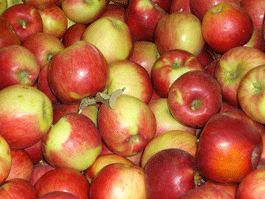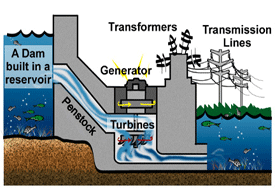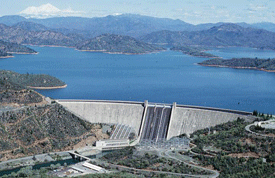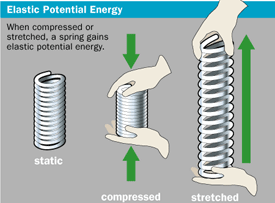Potential energy
is stored energy that can do work if it is made to. Potential
means having possibility, capability, or powerto do something.
An object can store energy as the result of its position.
Gravitational Energy, Nuclear Energy,
Stored Mechanical Energy and Chemical Energy
are all potential energies.
For example, the heavy heavy ball of a demolition
machine is storing energy when it is held at an elevated position.
This stored energy of position is referred to as potential
energy. Similarly, a drawn bow is able to store energy as
the result of its position. When assuming its usual position
(i.e., when not drawn), there is no
energy stored in the bow. Yet when its position
is altered from its usual equilibrium position, the bow is
able to store energy by virtue of its position. This stored
energy of position is referred to as potential energy. Potential
energy is the stored energy of position possessed by an object.
If you lift an object up, you put energy into
the gravitational field. This energy is not immediately apparent.
It is stored energy. The higher you lift the object, the more
the energy is stored in the gravitational field. So, the amount
of energy that is stored is a function of where you locate
the object, a function of how high up you lift it. Therefore,
potential energy is not only called stored energy, it is also
called energy dependent upon position
Chemical Energy is energy stored in the bonds
of atoms and molecules. Batteries, biomass, petroleum, natural
gas, and coal are examples of stored chemical energy. Chemical
energy is converted to thermal energy when we burn wood in
a fireplace or burn gasoline in a car's engine.
Mechanical Energy is energy stored in objects
by tension. Compressed springs and stretched rubber bands
are examples of stored mechanical energy.
Nuclear Energy is energy stored in the nucleus
of an atom — the energy that holds the nucleus together.
Very large amounts of energy can be released when the nuclei
are combined or split apart. Nuclear power plants split the
nuclei of uranium atoms in a process called fission. The sun
combines the nuclei of hydrogen atoms in a process called
fusion.
Gravitational Energy is energy stored in an
object's height. The higher and heavier the object, the more
gravitational energy is stored. When you ride a bicycle down
a steep hill and pick up speed, the gravitational energy is
being converted to motion energy. Hydropower is another example
of gravitational energy, where the dam "piles" up
water from a river into a reservoir.
.
Mechanical Energy is the energy of motion that
does the work. An example of mechanical energy is the wind
as it turns a windmill.
Heat energy is energy that is pushed into motion by using
heat. An example is a fire in your fireplace.
Chemical Energy is energy caused by chemical reactions. A
good example of chemical energy is food when it is cooked.
Electrical Energy is when electricity creates motion, light
or heat. An example of electrical energy is the electric coils
on your stove.
Gravitational Energy is motion that is caused by gravity.
An example of gravitational energy is water flowing down a
waterfall.
| 
Stored chemcial
energy
|

Stored chemcial
energy
|

Potential Gravitational
energy |

Potential Gravitational
Energy
|

Potential Gravitational
energy |

Potential Gravitational
Energy
|
| 
Potential Mechanical
Energy
|

Potential Mechanical
Energy
|

Potential Mechanical
Energy |

Potential Mechanical
Energy |
|